Quality, Consistency, Coherence: SST 11 Connects the Dots in Support of Districtwide Continuous Improvement on Behalf of Every Child
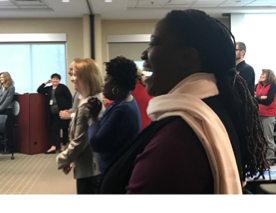
"Our position is that district/school improvement is really the foundation for all the work we do to assist districts in improving learning outcomes for all children," explained longtime educator Rhonda Dickson, Director of State Support Team Region (SST) region 11.
One of the largest of Ohio's 16 SSTs, SST 11 serves 51 traditional districts, 74 community (aka charter) schools, five educational service centers (ESCs), seven county boards of developmental disabilities, and a host of other education organizations (e.g., Department of Youth Services, Ohio State School for the Blind, Ohio School for the Deaf, career technical centers, etc.) across a seven-county region that is home to more than 550 individual school buildings. "All of our work, such as work related to special education, early childhood education, and literacy, aligns under the umbrella of district-school improvement," added Dickson.
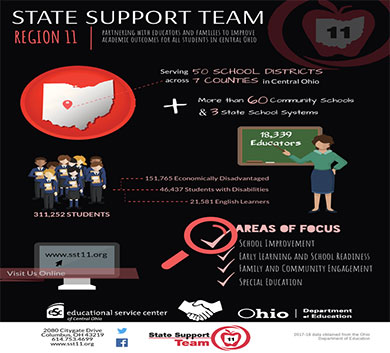
Organizing to Meet the Need
Under the state’s differentiated accountability system, districts and schools can be flagged as being in improvement status (i.e., Support Districts and Support Schools) and eligible to receive varying levels of support from SSTs. Districts in support status include districts designated as independent, watch, moderate support, intensive support, and Academic Distress Commission (ADC) districts. Schools in support status include those designated as priority, focus, warning, and watch schools.
For purposes of SST support, districts and their schools are identified across tiers of support, which include universal, targeted, and comprehensive. SSTs allocate 90 percent of their resources to providing support to comprehensive and targeted districts and the remaining 10 percent to providing universal support through information dissemination and other means to all districts in their regions. Regardless of the level of support, the goal is the same: to improve equitable access to a high-quality education for every child.
"The numbers keep growing and we have the largest number of community schools in the state," said Dickson. "Of the 74 community schools in the region, 60 to 65 have something the SST needs to address."
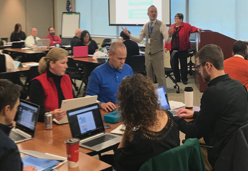
The number of SST 11 consultants employed to support district continuous improvement efforts ranges from 19 to 21 and not all consultants are employed on a full-time basis. According to Dickson, consultants are assigned to districts or community schools and everyone knows who is assigned to serve as SST point person for any particular district/school. Regardless of whether a district/community school is assigned as a moderate or intensive need district – or identified for comprehensive monitoring from the Ohio Department of Education's (ODE) Office for Exceptional Children for failing to meet state performance plan (SPP) indicators, or because of a parent finding – an SST consultant is assigned to work with that district/community school.
"We're large and assigning staff as point persons to district and community schools, and supporting them in working across service areas required in the ODE-SST grant agreement gives us an organizational structure for integrating the work internally," said Dickson. "We're working hard to ensure that messages to districts and schools are more consistent and that districts and schools see how all the work is linked," she added.
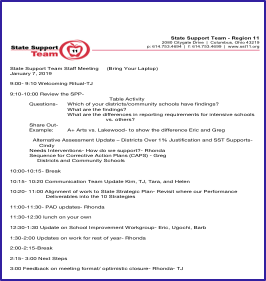
Integrating the Work to Gain Focus
Supporting districts and schools in gaining the focus needed to make and sustain improvements on behalf of all children is a major function of SST consultants who, as a group, bring different areas of expertise to the work. But first, the consultants need to understand how their work – across state-required areas (e.g., special education, improvement, early learning, literacy) – connects. And, they need to know how to have improvement conversations with districts and schools in ways that help them reduce fragmentation and unify their efforts toward the improvement of teaching and learning.
SST 11 consultants meet one and a half days per month as a group to update each other on the progress of assigned districts and schools, share strategies for integrating the work, and problem-solve together. A typical day-long agenda (see excerpt to the right) involves a combination of describing specific districts and how the SST is supporting them, discussing how the collective work of the SST aligns – or needs to be modified to align with – the state strategic education plan and other state priorities.
Dickson explains: "We look at all the data starting with the Ohio Report Card data and the SPP data, and look at all relevant documents in prepping to go into a district. We spend time thinking about what kind of questions to ask, how to listen, how to work with the district based on their data. Discussion about how to integrate the work becomes the focus of our internal meetings." SST staff also meet informally and hold impromptu meetings on an as-needed basis (e.g., to debrief after participating in an ODE webinar).
Rhonda Dickson, Director
SST Region 11
In addition to focusing on specific issues or areas of service based on district need, SST personnel have also shifted from using primarily a consultative model to providing coaching. "Some staff have participated in SPDG coaching and others have been entrenched with OLi4 and been able to develop coaching skills1. Throughout 2017 and 2018, SST staff participated in a Coaching Academy sponsored by Learning Forward as internal professional development, which provided all SST personnel with an opportunity to develop coaching skills," explained Dickson.
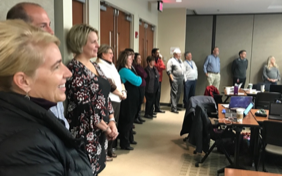
Challenges and Opportunities
SST 11 and its counterparts in other regions across the state form the foundation of Ohio’s statewide system of support (SSoS) – a system designed to help districts focus their work, implement high-leverage strategies across the system while avoiding the proliferation of disconnected strategies, and support continuous adult and student learning. The state’s improvement framework (the Ohio Improvement Process or OIP) provides a common framework and set of tools for all regional providers (e.g., SSTs, ESCs) to use in providing high-quality, consistent support to any district, regardless of where that district is located in the state.
"States look to Ohio because of our structures. Our regional system of support is strong. Having an additional structure beyond ESCs and the fact that our process is more systemic contribute to better implementation at the district level," offered Dickson who also noted that Ohio’s regional system is not without its challenges.
"Each region is a little different in terms of the needs it has to address. For example, our region has the highest number of SPP infractions this year across 57 entities, whereas another region doesn’t have any."
In August 2018, ODE completed the first phase of what has been referred to as the OIP reboot2, which served to affirm the work of the SSTs as being about districtwide continuous improvement, identified three critical areas of practice for organizing SST service delivery, set parameters for guiding service delivery by tier, and initiated a new measurement system for assessing the effect of SST services on district/school progress.
Improvement as the Primary Focus
"The reboot is great; it provides more focus and gives people the freedom to not feel guilty when they say they can’t come out and do three days of PD on any topic. It also sends the message that inclusive instructional and organizational leadership practice, capacity building through human capital management, and inclusive instructional practice are the foundation for our work. It gets everyone grounded back into the work of meaningful improvement," stated Dickson.
These three inter-related areas of practice – aligned with the state strategic education plan and integral to providing equitable access to high-quality instruction and support for every child in every school within the district – are defined as follows:
- Inclusive Instructional and Organizational Leadership that fosters a culture of inquiry and continuous learning on the part of all district personnel in order to provide equitable access to high-quality instruction and support for all children in every classroom in every school across the district;
- Human Capital Management that builds the capacity of the district to address its fundamental goals, including the recruitment, selection, onboarding and deployment of all personnel, and the provision of ongoing support to all personnel in the use of service delivery models that improve equitable access to high-quality instruction and support for all children; and
- Inclusive Instructional Practice that ensures equitable access to high-quality instruction and support, and improves learning outcomes for all children.
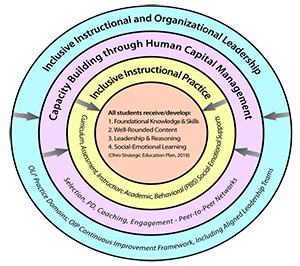
The reboot provides direction in the use of a tiered model by setting parameters for the areas in which SSTs provide support to districts with varying levels of need. Districts identified as needing comprehensive support receive services in all three areas of practice. Districts identified as in need of targeted support receive services from SSTs in the areas of capacity building through human capital management and inclusive instructional and organizational leadership. And, districts at the universal level of support receive services in the area of inclusive instructional and organizational leadership only.
According to Dickson, SST personnel have long been familiar with the use of a tiered model for delivering professional development, but "not necessarily for thinking about service delivery overall." In terms of the areas of practice, described above, SST 11 staff “have a good understanding of inclusive leadership because of their participation in OLi4, but need more experience in articulating the six areas of inclusive leadership practice in working with districts not already involved in the OLi4 project. They also need to develop a deeper understanding of how to support districts and schools in the use of inclusive instructional practices.”
Despite movement in the right direction, challenges persist. "With the staffing we have, we can only hit so many places and we don’t want staff to run so fast that all they do is click things off the list; it’s about quality work. We need well-respected entities that can help address some of the challenges we have. Five years from now it would be great if we didn’t have so many districts in improvement. Right now, we’re feeling the weight of all these districts and many of them are large," said Dickson.
In addition to supporting assigned districts, SST 11 staff participate in over 40 various state-led or supported work groups and committees that span the service areas outlined in the ODE-SST grant agreement, as well as book studies, webinars, and related activities. They also provide intensive support to districts and schools that participate as partners in several state initiatives, such as the SPDG and the early literacy pilot.
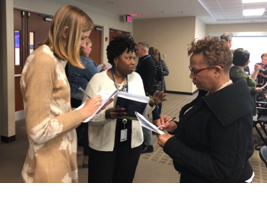
Supporting Improved Early Literacy Instruction
All SSTs are involved in supporting Ohio’s early literacy pilot and, through that involvement, are gaining valuable experience in supporting the use of evidence-based instructional practices in early literacy. "We’re in our third year in Lancaster City Schools and are operating a little differently than the other regions because in that we work with the Early Learning Center, a collaborative with Head Start, and Medill and Tallmadge elementary schools," explained Dickson. "Across both elementary schools, there are 56 educators, and an additional 26 at the Early Learning Center," she added.
The Early Literacy Pilot provides K-grade 3 teachers with high-quality professional learning through the Language Essentials for Teachers of Reading and Spelling (LETRS) professional development program. Additional resources being developed to support TBTs in identifying high-quality instructional materials and strategies based on a review of student data are helping TBT members make better decisions about instruction based on student needs.
"Using the OIP five-step process, having the OIP team structures, and understanding what high-quality literacy instruction looks like is making the difference," said Jake Campbell, principal of Tallmadge Elementary School in the Lancaster City School District. "We’re seeing more precise analysis of the data that will result in teachers keying in on using high-yield strategies that will move the needle for all of our students. We want cohesion in the process so we need to ask, ‘how do we extend this work to the upper grades?’" said Campbell.
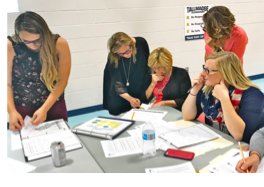
As a foundational strategy, the OIP makes use of aligned collaborative learning teams at the district, school, and classroom level3. These teams provide common structures for supporting meaningful instructional discourse among educators with multiple perspectives and areas of expertise.
Like other SST regions, SST 11 has a consultant on staff who is assigned to serve in the role of regional early literacy specialist – or RELS – providing support to the district coach, teachers, administrators, and others in the district. The SST 11 RELS spends two to four days per week supporting teachers in Medill and Tallmadge elementary schools. Another staff person from SST 11 is assigned to the Early Learning Center. SST 11 also houses one of the two adolescent literacy specialists for the state.
"SPDG funding has allowed Lancaster City to involve three additional buildings in the LETRS professional development," said Dickson. "Involvement in the early literacy work stretches our skills because we don’t have experienced curriculum people on staff. Many were special education directors at one time or have specific skillsets such as experience as a school psychologist or in another related services area," explained Dickson.
Striving for Sustainability and Scalability
"I see districts as learning organizations. Districts are paying more attention; they’re more savvy in looking at their data to make changes. We still have a lot of work to do, particularly in special education. Supporting special education directors by helping them see themselves as integral to the district/school improvement work would be a major accomplishment," said Dickson.
SST 11, like other regions across the state, serve an important role in diffusing learning across districts through the development and coordination of peer-to-peer networks. For example, SST 11 hosts a networked improvement community (NIC) for literacy leaders and will expand the network next year so that all districts can participate.
Fostering scalability – across schools within districts and across districts in the region – is facilitated by focusing on supporting districts to build their own capacity to learn and continuously improve on behalf of all children. “Moving to supporting district central office, rather than buildings in isolation, will be critical to sustaining and scaling improvements made through efforts like the early literacy pilot, observed Dickson.
References
Ohio’s leadership development framework (2nd ed.). (2013). Columbus, OH: Buckeye Association of School Administrators (BASA).
For More Information
For more information about SST 11 and its support of districts and schools in the central Ohio region, contact Rhonda Dickson, Director, SST region 11, 2080 Citygate Drive, Columbus, OH 43219; at 614.753.4707 or via email at rhonda.dickson@escco.org.
For more information about the OIP reboot and Ohio’s Statewide System of Support, contact Jo Hannah Ward, Executive Director, Center for Continuous Improvement, Ohio Department of Education, at 614.745.5365, or via email JoHannah.Ward@education.ohio.gov.
For more information about Tallmadge Elementary School’s use of the OIP to improve early language and literacy instruction, contact Jake Campbell, Principal, at 740.687.7336, or via email at j_campbell@lcsschools.net.
For more information about the OLAC and OIP resources, contact Dr. Jim Gay, OLAC Co-director, at jimgay@basa-ohio.org; or Karel Oxley, OLAC Co-director, at Oxley@basa-ohio.org.
1 SPDG is the state personnel development grant awarded to Ohio from the US Department of Education, Office of Special Education Programs. OLi4 is the Ohio Leadership for Inclusion, Implementation, and Instructional Improvement, a statewide professional development program for principals that is operated through the University of Cincinnati Systems Development & Improvement Center in Columbus.
2 See the October 2018 issue of the Cornerstone for additional information about the OIP reboot.
3 District leadership teams (DLTs), building leadership teams (BLTs), and teacher-based teams (TBTs). For more information, see Ohio’s Leadership Development Framework, accessible from at the Ohio Leadership Advisory Council (OLAC).